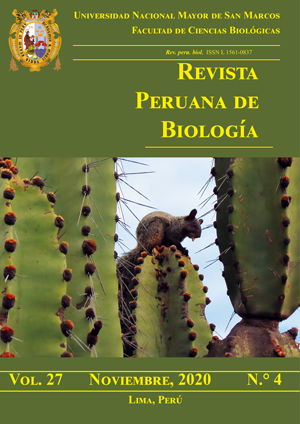Ecology and diagnosis of Enallodiplosis discordis (Diptera:Cecidomyiidae)
A fierce new defoliator with direct repercussions for loss of Prosopis dry forest and livelihoods in Peru
DOI:
https://doi.org/10.15381/rpb.v27i4.19200Keywords:
Algarrobo, ENSO, forest plagues, gall midge, Melipotis, Prosopis, insect plagueAbstract
The coastal desert of Peru and Chile is home to Prosopis (Leguminosae: Mimosoideae) tree species that are exceptionally well-adapted to the hyperarid conditions and keystone in dry-forest ecosystems. From 2001 to 2018, Prosopis in Peru have suffered widespread defoliation and die-back, with consequent deforestation and collapse in pod production. This paper reports a new insect plague species of Prosopis forest in Peru: Enallodiplosis discordis Gagné 1994 (Diptera: Cecidomyiidae) as a fiercely defoliating agent contributing to widespread Prosopis mortality. An analysis of E. discordis larval taxonomy, life cycle and plague infestation, following El Niño Southern Oscillation (ENSO) 1998/99 is provided. Using distinct lines of evidence, its spread, distribution, and ecology are examined. Over two decades of fieldwork, Prosopis forest die-back and loss was observed devastating rural livelihoods and ecosystem services across lowland regions of southern (Ica), central and northern coastal Peru (Lambayeque, La Libertad, Piura). The collapse in production of Prosopis pods (algarroba, huaranga) and honey was recorded. Supplementary notes provide observations of: (i) plague development, changing land-use and climate, (ii) biological and physical control of E. discordis, (iii) the moth Melipotis aff. indomita (Lepidoptera: Noctuidae) as a concurrent defoliator of Prosopis.
Downloads
Downloads
Published
Issue
Section
License
Copyright (c) 2020 Oliver Q. Whaley, Consuelo Borda, Justin Moat, Tim Wilkinson, Ana Bravo Sánchez, Raymond J. Gagné

This work is licensed under a Creative Commons Attribution-NonCommercial-ShareAlike 4.0 International License.
AUTHORS RETAIN THEIR RIGHTS:
a. Authors retain their trade mark rights and patent, and also on any process or procedure described in the article.
b. Authors retain their right to share, copy, distribute, perform and publicly communicate their article (eg, to place their article in an institutional repository or publish it in a book), with an acknowledgment of its initial publication in the Revista Peruana de Biologia.
c. Authors retain theirs right to make a subsequent publication of their work, to use the article or any part thereof (eg a compilation of his papers, lecture notes, thesis, or a book), always indicating its initial publication in the Revista Peruana de Biologia (the originator of the work, journal, volume, number and date).






